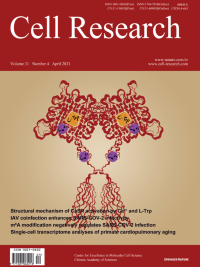
Advanced Search
Submit Manuscript
Advanced Search
Submit Manuscript
Volume 31, No 4, Apr 2021
ISSN: 1001-0602
EISSN: 1748-7838 2018
impact factor 17.848*
(Clarivate Analytics, 2019)
Volume 31 Issue 4, April 2021: 404-414 |
The m6A methylome of SARS-CoV-2 in host cells
Jun’e Liu1,2,3 , Yan-Peng Xu4 , Kai Li1,5,6 , Qing Ye4 , Hang-Yu Zhou7 , Hanxiao Sun1 , Xiaoyu Li1 , Liu Yu4 , Yong-Qiang Deng4 , Rui-Ting Li4 , Meng-Li Cheng4 , Bo He5,6 , Jia Zhou4 , Xiao-Feng Li4 , Aiping Wu7 , Chengqi Yi1,6,8,* , Cheng-Feng Qin4,*
1State Key Laboratory of Protein and Plant Gene Research, School of Life Sciences, Peking University, Beijing 100871, ChinaThe newly identified Severe Acute Respiratory Syndrome Coronavirus 2 (SARS-CoV-2) has resulted in a global health emergency because of its rapid spread and high mortality. The molecular mechanism of interaction between host and viral genomic RNA is yet unclear. We demonstrate herein that SARS-CoV-2 genomic RNA, as well as the negative-sense RNA, is dynamically N6-methyladenosine (m6A)-modified in human and monkey cells. Combined RIP-seq and miCLIP analyses identified a total of 8 m6A sites at single-base resolution in the genome. Especially, epidemic strains with mutations at these identified m6A sites have emerged worldwide, and formed a unique cluster in the US as indicated by phylogenetic analysis. Further functional experiments showed that m6A methylation negatively regulates SARS-CoV-2 infection. SARS-CoV-2 infection also triggered a global increase in host m6A methylome, exhibiting altered localization and motifs of m6A methylation in mRNAs. Altogether, our results identify m6A as a dynamic epitranscriptomic mark mediating the virus–host interaction.
https://doi.org/10.1038/s41422-020-00465-7